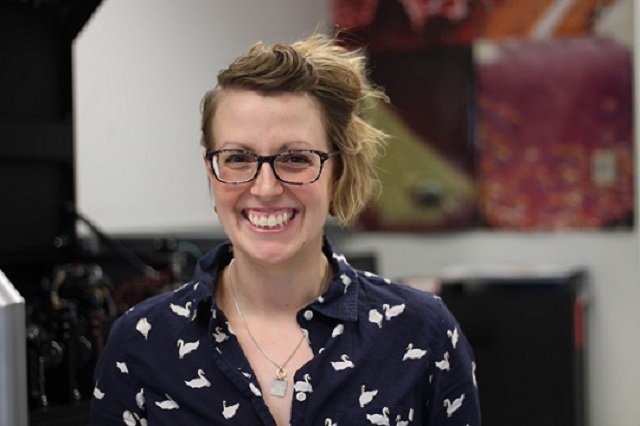
Flow Cytometry Core Manager Aja Rieger has received a 2017 International Society for Advancement of Cytometry Shared Resource Lab Emerging Leaders Award.
If you have no idea what flow cytometry is, you are in good company. Untrained eyes would not likely grasp the value of the work made possible in the University of Alberta's flow cytometry lab. It is difficult to make heads or tails from the array of lenses, lasers and wires connected by tubes to the meticulously labeled bottles of fluid.
Aja Rieger, Flow Cytometry Core manager, offers a simple explanation: "Flow cytometry allows you to look at multiple things going on in a single cell at the same time, and to look at hundreds of thousands of cells in a matter of minutes. Usually people look at, maybe hundreds of cells, but being able to look at hundreds of thousands of cells, or millions of cells, you get so much more information."
Rieger's gift for making sense of complex data and teaching others to use the flow cytometry equipment is what makes her one of the 2017 International Society for Advancement of Cytometry Shared Resource Lab Emerging Leaders. She manages the Faculty of Medicine & Dentistry's Flow Cytometry Core, a shared resource research facility that houses state-of-the-art instruments, accessible to anyone across campus. Most users are from the medical fields, however there are more than 100 labs subscribed, including several from the fields of chemistry, biology, engineering and agriculture. The benefit of a shared lab, according to Rieger, is that the technology is very expensive. "A lot of research would not be possible for individual labs or projects due to the prohibitively high cost and expertise required to purchase and maintain the equipment," she says.

Rieger's recognition as a leader in cytometry is good news for the U of A. "The award signifies that our core, as it is currently being managed, is one of the top five facilities internationally this year," says Rieger. "There are a lot of international facilities with a pretty big pool of applicants. So it's a huge achievement."
Flow cytometry can be applied to a range of medical fields including diagnostics, immune disorders and cancer research. It's especially important for transplantation immunology, which has a designated transplantation flow core at the University of Alberta Hospital. "You can look at anything from the surface to inside the cytoplasm to the mitochondria," Rieger says. "As long as you can get an antibody there, you can see if it's expressing what you think it is, so the possibilities are endless."
Tom Hobman, cell biologist and Canada Research Chair in RNA Viruses and Host Interactions, agrees that the U of A's flow cytometry lab is a gem. "It's a state-of-the-art facility and it's not easy to stay on top and be at the cutting edge of this field because it's changing so rapidly, but Aja has managed to do that. She's able to educate users, ranging from undergraduates, graduate students, postdoctoral fellows, as well as technicians and principle investigators, and break down the barriers to this field of analysis which is really quite daunting if you've never done it before."
The technology itself is not new, but it takes someone like Rieger to understand the possibilities and make them visible to others. "Now that she's there, we use the lab all the time," says Hobman who applies the flow cytometry science in his own research on the Zika virus, West Nile and Dengue fever. "In fact, we're one of the heaviest users now, and that's in large part because of Aja helping to break down the barriers, to show us how powerful this technology can be."
"It's a workhorse facility. It's probably one of the busiest facilities we have. Some of the instruments are going all day long and through the night," Hobman says. Given the high demand, expert coordination is required to ensure that things run smoothly. "We're very lucky to have recruited Aja, she's an asset to the whole community."
